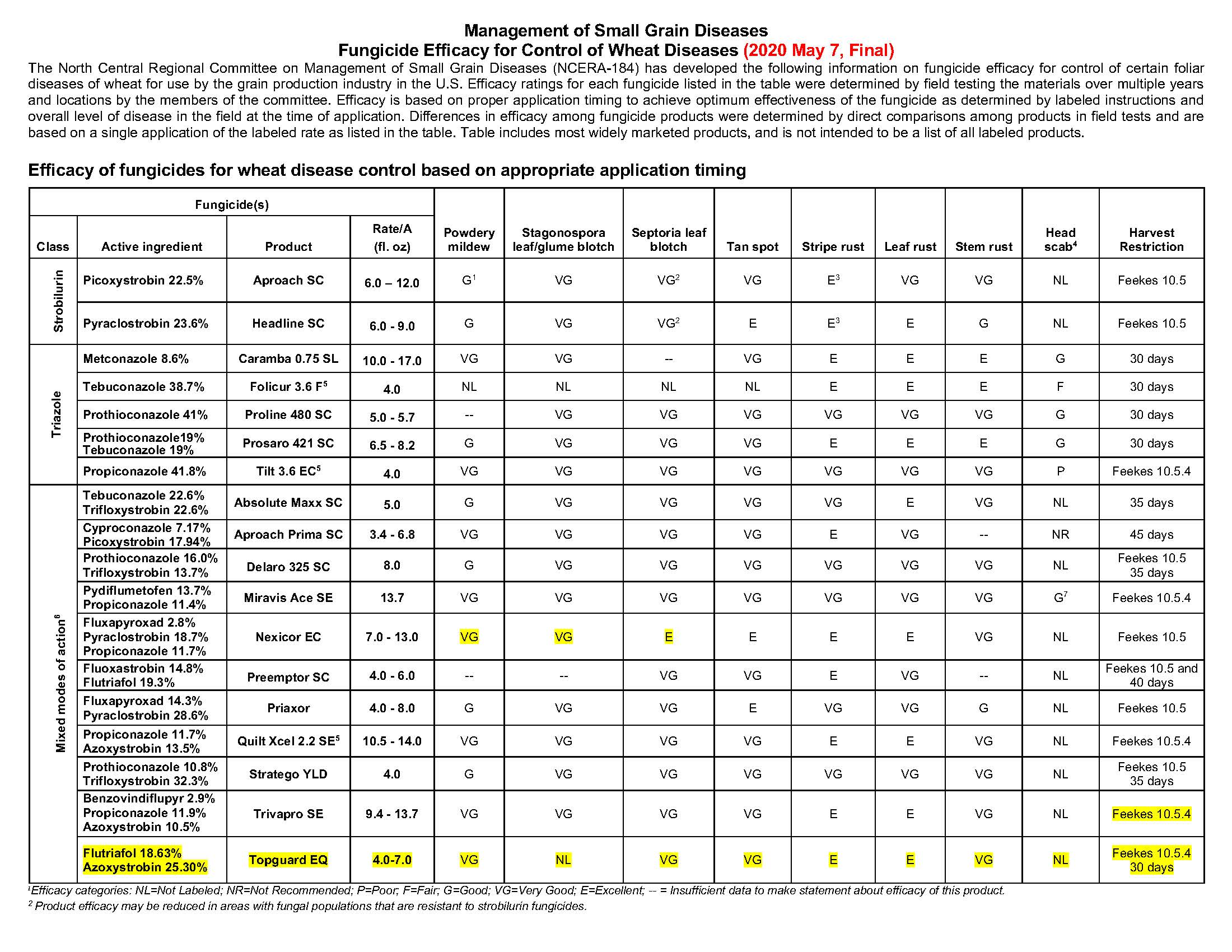Xianming Chen
Latest use of Fungicides
In the recent days, I have got several e-mails and phone calls about the latest stage for applying fungicides. Attached is a list of fungicides for managing foliar wheat diseases (including stripe rust) with harvest restrictions. These fungicides can be grouped based on their latest stage or days before harvest for application:
1) Fungicides that can be used up to Flowering (Feekes 10.5)
Aproach SC 6.0 – 12.0 fl oz/A
Headline SC 6.0 – 9.0 fl oz/A
Delaro 325 SC 8.0 fl oz/A
Nexicor EC 7.0 – 13.0 fl oz/A
Preemptor SC 4.0 – 6.0 fl oz/A
Priaxor 4.0 – 8.0 fl oz/A
Stratego YLD 4.0 fl oz/A
2) Fungicides that can be used up to Flowering completed; kernel watery ripe (Feekes 10.5.4)
Tilt 3.6 EC 4.0 fl oz/A
Miravis Ace SE 13.7 fl oz/A
Quilt Xcel 2.2 SE 10.5 – 14 fl oz/A
Trivapro SE 9.4 – 13.7 fl oz/A
Topguard EQ 4.0 – 7.0 fl oz/A
3) Fungicides that can be used up to 45 days before harvest
Aproach Prima SC 3.4 – 6.8 fl oz/A
4) Fungicides that can be used up to 40 days before harvest
Preemptor SC 4.0 – 6.0 fl oz/A
5) Fungicides that can be used up to 35 days before harvest
Absolute Maxx SC 5.0 fl oz/A
Delaro 325 SC 8.0 fl oz/A
Stratego YLD 4.0 fl oz/A
6) Fungicides that can be used up to 30 days before harvest
Caramba 0.75 SL 10.0 – 17.0
Folicur 3.6 F 4.0 fl oz/A
Proline 480 SC 5.0 – 5.7 fl oz/A
Prosaro 421 SC 6.5 – 8.2 fl oz/A
Topguard EQ 4.0 – 7.0 fl oz/A
For the fungicides listed in two categories of latest application (such as Delaro 325 SC, Preemptor SC, Stratego YLD, and Topguard EQ), the one comes first should be considered as the restriction. Some of the above listed fungicides, such as Folicur, Tilt, and Quilt Xcel, there are different commercial names, check the active ingredients. Folicur contains 38.7% Tebuiconazole. Tilt contains 41.8% Propiconazole. Quilt Xcel contains 11.7% Propiconazole and 13.5% Azoxystrobin.
Check fungicide labels for both the latest use and the total amount for a crop season.
Other Concerns
1) Not all varieties need fungicides. Many wheat varieties have adequate resistance to stripe rust even under this year’s relatively severe situation. The stripe rust ratings in our Stripe rust website (https://striperust.wsu.edu/nursery-data/2019-nursery-data/), the VarietySelection of the WSU Small Grain website (https://varietyselection.cahnrs.wsu.edu/), or the recent Seed Buying Guide (http://washingtoncrop.com/seed/seed-buying-guides/). The last year’s stripe rust data and ratings of the WSU Variety Trails are attached. In general, varieties with ratings 1-4 do not need fungicide while 5-9 need fungicides under this year’s rust situation. For varieties like Bruehl, Cara, and Norwest 553 that we have not seen rust in many years, fungicides are not needed. Spring varieties Seahawk (with Yr5 and Yr15 for all-stage resistance and HTAP resistance) and Expresso (with Yr15 and HTAP resistance) should be stripe rust free. Either Yr5 or Yr15 is highly resistant to all races identified so far in the United States. So these varieties do not need fungicide for control of stripe rust. If you concern about potential new races attacking previously highly resistant varieties (currently, stripe rust found on ‘Bobtail’ in western Oregon is a concern), it is always good to check fields. If active or fresh stripe rust pustules (producing yellow-orange powders) are found, consider to use fungicide. Checking fields also allow you to find other diseases (such as leaf rust and powdery mildew) that can be controlled by same chemicals as for control of stripe rust. If stripe rust incidence (percentage of plants having rust) is about 5%, considering use fungicide. For example, Seahawk should not have any stripe rust problem until virulence races that may appear in the future (but not very soon), this variety may have leaf rust problem. So far, we have not seen or heard leaf rust in the Pacific Northwest (PNW) this year, but it is always a good idea to check your fields.
2) HTAP Resistance. Almost all wheat varieties currently grown in our PNW region have HTAP resistance; many have HTAP resistance and all-stage resistance that have some protection; and few have HTAP resistance together with clear, highly effective all-stage resistance genes like Yr5 and Yr15 as mentioned above. However, the levels of resistance or just HTAP resistance, in wheat varieties varied a lot, ranging from 1 to 8 (rating 9 for highly susceptible). HTAP resistance is affected by temperatures and growth stages. In general, HTAP resistance starts after tillering and becomes more effective when plants grow older and weather becomes warmer (usually daytime temperatures above 65oF and nighttime temperatures above 50oF). Stripe rust will stop infection when night temperature consistently above 70oF (many areas in the PNW do not have such condition), but can decrease if the daily minimum does not go below 65oF and daily maximum goes to 90s F. In general. The weather conditions (cool and wet) in the past two weeks and forecasted for this week and next week are very conducive for stripe rust development and less favorable for HTAP resistance.
3) Economic Return. The current stripe rust pressure is in agreement with the forecast made in March, i.e. highly susceptible varieties (nobody grow) are likely to have about 48% yield loss and most susceptible commercially grown varieties (such as Eltan, ORCL 102, Xerpha, and Curiosity CL+) are likely to have about 24% yield loss without use of fungicides. Varieties with stripe rust ratings 5 are likely to have 5% to 10% yield loss. To make even, fungicide application needs to save about 3 – 4 bushels, which is about 3 – 4% of the grain yield with the yield potential of 100 bushels per acre.
